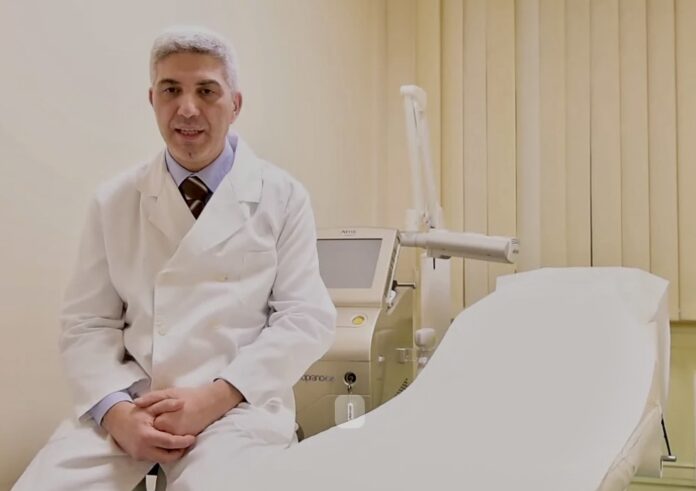Fairness Magazine & Dott. Maurizio Nudo
L’arrivo della primavera coincide con il momento dell’anno in cui prestiamo la maggior attenzione alla nostra pelle. Questo accade perché i primi caldi fanno sì che zone di cute tenuta coperta nei lunghi mesi invernali tornino finalmente a essere esposti mostrando in alcuni casi alcune imperfezioni che destano, giustamente, la nostra curiosità.
È il momento giusto, ove questo accadesse, di recarsi da un dermatologo per sottoporsi a una visita di controllo.
«La prima preoccupazione – dice il Dottor Maurizio Nudo, responsabile del Servizio di Dermatologia di Humanitas Castelli Bergamo, deve essere quella di sottoporre all’attenzione dello specialista i propri nei, così che sia possibile verificare se ce ne siano “a rischio”. Complice il Covid, negli ultimi due anni non ci sono state molte possibilità di sottoporsi a visite dermatologiche, per cui è importante farlo ora, per prevenire quanto più possibile l’eventuale formazione di tumori della pelle che, proprio perché i controlli nei mesi passati sono diminuiti, stanno registrando in questi ultimi tempi un costante aumento».

Il controllo della pelle alla ricerca di eventuali formazioni cancerose deve riguardare solo i nei?
«No, un’altra situazione che deve essere valutata con attenzione dal dermatologo sono le piccole macchie rosse presenti sulla pelle e caratterizzate da una fine desquamazione, che possono essere il segnale di forme iniziali di precancerosi, chiamate cheratosi attiniche».
Tra le problematiche della pelle più diffuse in questo periodo dell’anno ci sono le micosi. In che cosa consistono?
«Le micosi della pelle riguardano soprattutto parti del corpo come il tronco e gli arti superiori. Sono provocate dalla pitiriasi versicolor, patogeno dando luogo a chiazze color caffelatte o rosate, anche in questo caso desquamanti e che procurano un intenso prurito».
La micosi può interessare anche le unghie?
«Sì, parliamo delle onicomicosi, patologie che colpiscono prevalentemente le unghie dei piedi ma anche quelle delle mani. In questi casi è molto importante sottoporsi a una visita dermatologica, perché spesso quelle che sono credute problematiche dovute alla presenza e alla proliferazione di un fungo non sono altro che traumi dovuti all’utilizzo di scarpe troppo strette o di calzature specifiche utilizzate sui luoghi di lavoro, come ad esempio quelle di protezione individuale. La giusta individuazione della causa è importante perché permette di adottare la cura più efficace per il singolo caso».
Altre patologie che si presentano con una certa frequenza in questo periodo dell’anno sono le fotodermatiti, come ci si deve porre al riguardo?
«Le fotodermatiti altro non sono che forme di dermatiti legate all’esposizione al sole. In genere chi viene a farsi visitare lo fa per evitare di trovarsi nella stessa condizione degli anni scorsi, quando dopo le prime esposizioni al sole si è trovato con la pelle “rossa come un peperone”. In questi casi lo specialista dispone l’esecuzione di esami del sangue, utili a verificare come stia funzionando il sistema immunitario del soggetto interessato. Oltre alle fotodermatiti bisogna stare attenti a disturbi che sono difficili da
riconoscere perché si presentano sotto forma di scottature, mentre invece sono una vera e propria patologia della pelle che, se trascurata, può lasciare cicatrici perenni. Si dice che questa patologia “mangi” la pelle, per questo viene chiamata Lupus eritematoso cutaneo, come se il danno provocato fosse opera di un lupo».
Anche la dermatite atopica fa la sua comparsa in queste settimane …
«Esatto, la dermatite atopica colpisce in particolare i bambini e compare soprattutto in questo momento dell’anno contraddistinto da sbalzi di temperatura, in cui convivono giornate ancora collegate al freddo inverno e giornate già proiettate verso i tepori primaverili. I bambini che geneticamente hanno una pelle più sensibile subiscono gli effetti di questi sbalzi di temperatura e grattandosi procurano danno alla loro pelle, che risulta essere più secca del normale. Il risultato è lo sviluppo di eczemi che possono portare anche a infezioni, perché le mani, soprattutto quelle dei più piccoli, non sempre sono pulite».

Poi c’è la psoriasi, patologia che si sviluppa soprattutto nel periodo invernale ma di cui ci accorgiamo a volte solo con i primi caldi. Perché avviene questo?
«E vero che si tratta di una forma che trova la sua massima espressione in inverno, ma è altrettanto vero che è adesso che la persona che ne è colpita avverte l’esigenza di curarsi, così da arrivare all’estate con la pelle “pulita”. Perché le squame argentee tipiche della psoriasi – che si presentano su gomiti, ginocchia, cuoio capelluto e tronco – sono considerate antiestetiche e quindi c’è l’esigenza di eliminarle. È un problema di natura sociale, oltre che medica, che riguarda l’interazione con le altre persone. Per questo si spera di raggiungere almeno una parziale soluzione di questa problematica cutanea».
E per finire, parliamo della dermatite seborroica, come si presenta?
«La dermatite seborroica appare con un colorito rosso intenso sulle arcate sopraciliari e sui solchi naso genieni. Molti pazienti arrivano esasperati dal dermatologo, perché è tutto l’inverno che soffrono per questo problema e adesso che arriva la bella stagione non accettano più di vedere il loro viso in queste condizioni. Si pensa spesso che questo tipo di dermatite possa essere risolto con il faida-te, utilizzando creme al cortisone acquistate in farmacia o su internet, ma non è così. Non bisogna dimenticare che il cortisone è come se fosse una droga: quando lo sospendi la dermatite si presenta ancor più forte di prima.
È importante, dunque, prima di compiere qualsiasi passo, sentire il parere di un dermatologo, cui è demandato il compito di indicare la migliore cura per il caso specifico».
In generale, è sempre meglio evitare le cure fai-da-te? Anche quando i problemi della pelle sembrano minimi?
«Sì, le cure fatte in casa devono sempre essere evitate, perché quello che può sembrare un problema di poco conto può nascondere invece una condizione da tenere sotto controllo con spesso non riesce a capire se una certa reazione della pelle dovuta a una fase infiammatoria acuta o piuttosto a un esagerato e sbagliato del farmaco assunto o utilizzato di propria iniziativa».
Un ringraziamento al Dott. Maurizio Nudo per i contenuti: https://maurizionudo.it/
Ig – @fairness_mag




